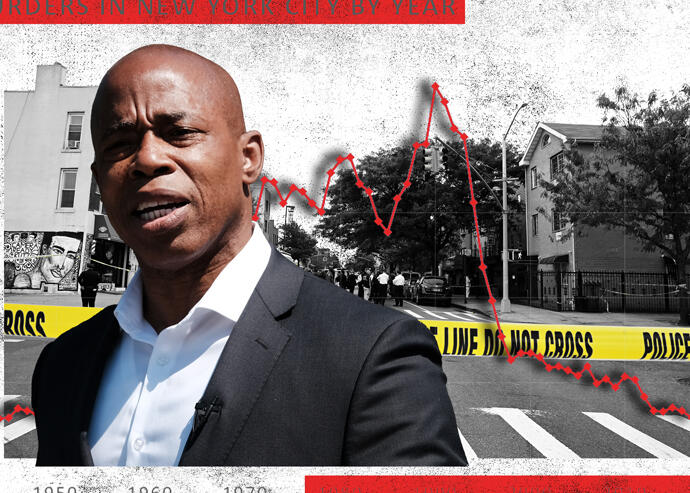
Erik Adams (Getty, Robmagin1/Wikimedia)
Bill Bratton, Ray Kelly, Thomas O’Neill and Rudy Giuliani know exactly what drove crime down in New York City: They did, of course.
The police commissioners’ strategies — CompStat, precision policing, stop-and-frisk, data analysis and more — and the mayor’s zero-tolerance approach coincided with a breathtaking drop in crime that lasted from the early 1990s until the pandemic.
The real estate industry profited handsomely. Nothing is more important to the value of homes, offices and retail spaces than the ability to get to and from them safely. As confidence grew in subways, parks and neighborhoods once considered dangerous, so did rents and prices. Tourism doubled and shopping corridors flourished. Foreign professionals flocked here to work.
The reality is, no one knows why crime fell. But to credit New York City’s police and political leadership would be to ignore that crime simultaneously fell in cities across the nation — and in many other nations as well. The drop was especially pronounced in New York, where homicides plunged from 2,245 in 1990 to 292 in 2017, but that is in part because crime was incredibly high at the outset.
Theories abound. Improved police technology and strategy — such as focusing on prevention rather than arrests and response time — likely played a role, but stop-and-frisk almost certainly did not, considering that crime kept falling as the practice was scaled back from 686,000 stops in 2011 to just over 13,000 in 2019.
Increasing the size of the NYPD — which began with Mayor David Dinkins, not his successor, Giuliani — probably helped, as studies show that adding cops reduces crime. But Mayor Michael Bloomberg cut police headcount by several thousand, figuring that fewer cops were needed because crime was down. And it kept falling.
Some observers link the legalization of abortion in 1973 to the beginning of the crime drop 17 years later, when those unwanted children would have begun breaking the law. A more likely factor was the phaseout of leaded gasoline starting in 1975, which led to an enormous reduction in airborne lead particles’ damaging city children’s brains. A plausible result is that urban men coming of age in the 1990s and 2000s had better impulse control than their counterparts of the 1970s and 1980s.
The point is, New York City politics and policies had little to do with crime falling. And they probably had little to do with crime rising in 2020 — it went up in most U.S. cities last year as the pandemic disrupted routines and increased stress.
Why, then, did New Yorkers — and real estate executives in particular — pick a former police captain, Eric Adams, as their next mayor?
One reason is that most do believe a mayor can make a difference on crime. They have not combed through the white papers of criminologists and sociologists trying in vain to figure out why crime goes up and down. What they do know is that crime is up over the past 18 months and New Yorkers feel less safe.
They also feel the rising tension between police and the Black community since George Floyd’s murder. Given the choice of candidates, Adams seemed best equipped to deal with crime, policing reform and police-community relations.
Most real estate executives — even those who credit Giuliani and Bloomberg with fixing the crime problem — understand that the police are not perfect. Some even get that law enforcement’s shortcomings contribute to criminality. There’s a reason why street culture calls for avenging petty beefs rather than trusting cops to deliver justice.
Adams was the only mayoral contender with the credibility and willingness to criticize the police and the people they are arresting. Some mocked his “Stop the Sag” initiative to get young men to stop walking around with their underwear showing, but his voters agreed with him and respected his courage to speak up.
Adams says he has the recipe to turn things around. Whether Adams can make an omelet is uncertain, but we know this: He is willing to break the eggs.



